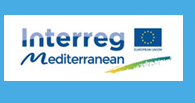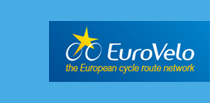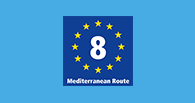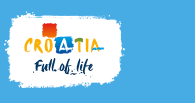Welcome to the official website of EuroVelo 8 - Mediterranean Cycle Route in Croatia
This website will help you plan your vacation and navigate better the seven Croatian tourist regions from Istria to Dubrovnik-Neretva County, through which the Croatian EuroVelo 8 cycling route runs.
Information available on this site includes mapping and GPX tracks, descriptions of basic and alternative route sections in Croatia, information on route surface quality, traffic density, supply and accommodation options, tourist attractions, public transportation options, bike services and shops, and recommendations for safe rides and a pleasant cycle tourist vacation in Croatia.
At this stage of the route's development, occasional shorter macadam sections, more intense motor traffic, and shared pedestrian traffic are expected. Since signalling is located on a smaller part of the route and the optimal route involves a lot of turns, it is advisable to orient using navigators (GPS receivers and GPX tracks available on this site).
We wish you a happy and safe journey and an unforgettable vacation on the EuroVelo 8 route in Croatia.
Main and alternative route sections
The main EuroVelo 8 route consists of 20 daily sections G1-G20, which stretch from Istria to Dubrovnik. In the area from Rijeka via Otočac and Gospić to Lovinac, the main EuroVelo 8 route passes through an attractive, somewhat hilly and forested areas of the hinterland of Vinodol, National Park Northern Velebit and Lika, which provide refreshment and peace in the summer months.
Alternative sections of the EuroVelo 8 Route , consist of 8 daily sections A1-A8, which give you the possibility of a different direction of movement along the EuroVelo 8 route in Croatia. For example, from Plomin in Istria, it is possible to take the island version of EuroVelo 8 via the islands of Cres, Krk, Rab and Pag using sections A1, A2, A3 and A4. Both versions are very attractive, and it is convenient to merge them into a round trip along the North Adriatic area.
The mentioned division of the route into sections is just one of many options. Cycle tourists can also create their own daily sections depending on their interests, riding habits, physical fitness and weather conditions.
Recommended direction of riding and detours
The recommended EuroVelo 8 route in Croatia was created according to ECS criteria (European Certification Standard) for the development of the EuroVelo routes of the ECF - European Cycling Federation, used within the EU MedCycleTour project, and with the aim of achieving optimum balance among the direct line of the route, safe and comfortable ride and the attractiveness of the area the route passes through. Cyclists and cycle tourists may have different preferences in optimizing their travel, so alternative sections are provided offering a Mediterranean or an island ride with more marine atmosphere (A1, A2, A3, A4), a more direct route (A5), or less busy roads of the Dalmatian hinterland or islands. (A6, A7, A8).
The recommended, main direction of the entire EuroVelo 8 route in Croatia is from northwest to southeast. The route can also be ridden in the other direction, but due to the configuration of the terrain, the basic recommended direction is better and safer. The route descriptions and GPX tracks of daily sections of the route are adapted to the basic route direction, and the reverse direction occasionally changes or deviates from the basic route direction, especially because of one-way streets in cities
In some cases, detours of the daily sections are offered for cycle tourists who want to avoid stairs or a macadam section or want to pass through a small town for supplies or overnight stay.
General instructions for viewing the route sections
The classification of traffic intensity into moderate, high and very high was done according to the ECS criteria s a combination of speed and volume criteria for motor traffic (ECS Manual, pages 20-21):
| Cycling in mixed traffic | 30 km/h or lower | 31 to 50 km/h | 51 to 79 km/h | 80 km/h or over |
|---|---|---|---|---|
| 1-500 units/day | very low | very low | very low | low |
| 501-2.000 units/day | very low | low | low | moderate |
| 2.000-4.000 units/day | low | moderate | moderate | high |
| 4.001-10.000 units/day | moderate | high | high | very high |
| >10.000 units/day | moderate | very high | very high | very high |
Macadam surface marked as “well rideable” is dry and solid and suitable for driving a loaded trekking bike at a speed of 20 km/h. Moderately or badly rideable macadam surface could be bumpy or could include puddles or poorly fixed gravel, which is less well rideable.
The abbreviations Dxxx for state roads, Žxxxx for county roads and Lxxxxx for local roads are commonly used. Road numbers are in most cases visible on road signings.
Accommodation, gastronomic and supply facilities on daily sections are especially highlighted only if they are rare, and in major cities they are not mentioned.
Rest areas are highlighted if they are especially suitable (park, benches, rest stops, beaches), but rest is mostly possible anywhere along the route.
Route detours
Due to the criteria of developing the EuroVelo routes as direct as possible, some of the national parks and/or nature parks and other attractions are located 10 to 20 km outside the EuroVelo 8 route. In such cases a possibility of detour and access to major tourist attractions is marked in order to provide information for planning one’s trip and stay on the sections of the route.
Recommended riding season
Spring and autumn are recommended for riding along the EuroVelo 8 route in Croatia, and it is advisable to check availability of tourist services in a certain destination before departure and to book them in advance.
Responsible and safe ride along the EuroVelo 8 route
Enjoy discovering beauties of the Croatian part of the EuroVelo 8 route by taking responsibility to yourself and others.
- Obey traffic rules!
- A bicycle is a vehicle subject to the rules of the Traffic and Road Safety Act.
- Ride near the right edge of the road, with two or more cyclists in a group behind each other.
- At night cyclists must have their white front and red rear lights lit and they should wear a reflective vest or reflective clothing.
- Bikes should also have ‘cat eye’ front, rear, pedal and wheel reflectors.
- A helmet is mandatory for cyclists under 16 years of age and it is recommended for others too, especially on busy sections of the route.
- At pedestrian crossings without marked bicycle lanes, it is necessary to get off the bike.
- While cycling, warn other road users of your intentions, especially while entering intersections and roundabouts.
- Mobile phone use while cycling is not allowed.
- Cycling on pedestrian zones is not allowed.
- Drive carefully and cautiously
- Stay focused and concentrated while cycling. Do not use headphones.
- Ride carefully and defensively. Be prepared to compensate for the possible mistakes of other road users.
- Wear conspicuous, bright coloured clothes.
- Show solidarity with other road users you share the road with: give priority to pedestrians, let the slow-moving cars behind you overtake you, clearly indicating your intentions.
- Cycle according to your own capability - experience, skills and fitness - and plan your daily sections accordingly.
- Think of the general safety precautions for cycling and ensure that you have:
- enough water and food supplies,
- technically correct bikes, tools and spare parts,
- charged batteries for your mobile phones and other devices
- appropriate clothing and cycling accessory, helmets,
- navigation (GPS devices on the bike)
- Take active responsibility in caring for the environment.
- Do not light a fire.
- Do not dump your garbage in nature.
- Do not make noise and do not scare animals.
Use the EuroVelo 8 route at your own risk.



